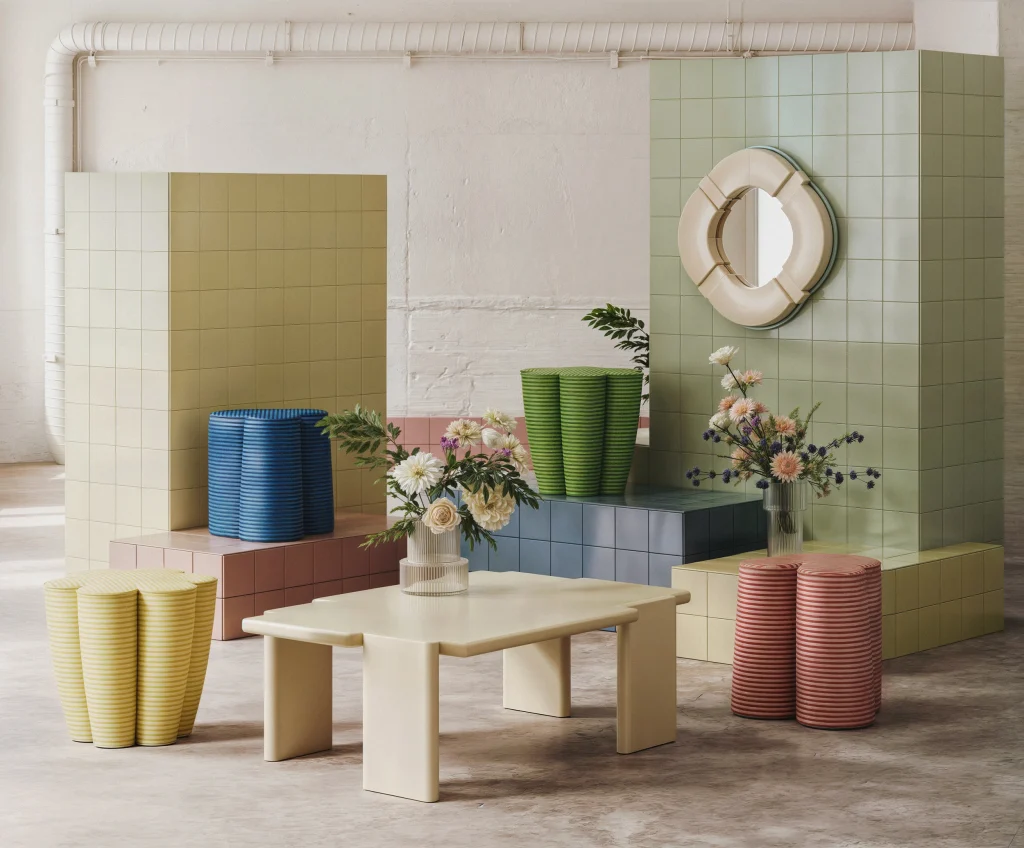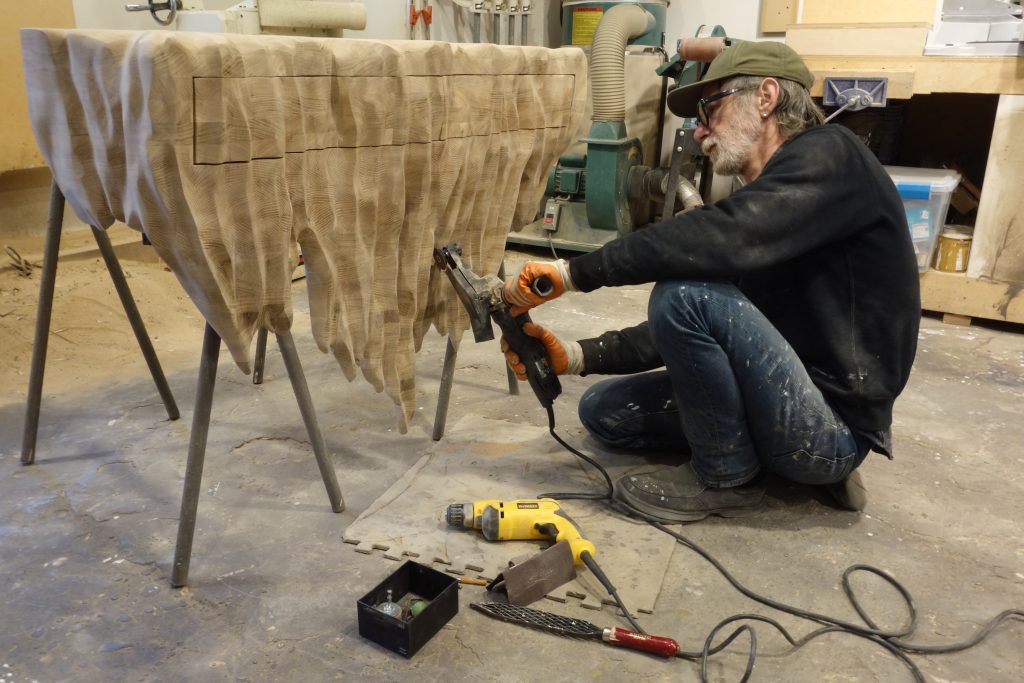
Lou van ‘t Riet: Bridging the gap between the viewer and the work
Belgian designer Lou van ‘t Riet‘s artistic journey, which began in Brussels and blossomed during her transformative years in New York, has reshaped conventional interactions between art and its audience. Influenced by iconic spaces and artworks she encountered in the U.S., such as Dia Beacon and The Glass House, van ‘t Riet returned to Brussels with a renewed vision for her craft. Her exposure to these sites, known for their immersive and expansive presentations, left a profound impact on her understanding of space and viewer engagement, steering her away from the passive experiences predominant in many galleries and museums.






Upon her return, van ‘t Riet ventured to bridge the gap between artwork and observer, challenging the traditional boundaries with her first solo exhibition after the COVID pandemic. This show marked a significant departure from normative engagements by inviting tactile interactions with the art, an approach that garnered mixed reactions ranging from delight to hesitance among her audience.








Her signature Triptych series epitomizes this innovative approach. These works are dynamic, crafted to be manipulated by viewers, thus allowing them to actively participate in the art itself. Through these interactive pieces, van ‘t Riet invites a dialogue that transcends the usual ‘look but don’t touch’ paradigm, fostering a more immersive experience.
“Through my creations I aim to bridge this growing gap and break the ‘do not touch’ rule.”
Lou van ‘t Riet
The craftsmanship behind these pieces is as meticulous as it is intentional, with each triptych handcrafted in Belgium using durable materials like steel to withstand interaction. This choice underscores her commitment to both aesthetic appeal and functional resilience, ensuring that her works can engage viewers repeatedly without degradation.






Van ‘t Riet’s experiences at the Chamber Gallery and with multidisciplinary artist Katie Stout further enriched her approach, blending art and design in ways that challenge and redefine the roles of creator, object, and consumer in artistic spaces.
As we explore Lou van ‘t Riet’s contributions to contemporary art and design through our interview, her works stand as vibrant examples of how design and craftsmanship can fuse into functional art, inviting us to reconsider our roles as passive viewers and become active participants in the art we encounter.




In your transition from Brussels to New York, how did the change in cultural and artistic landscapes influence your approach to design and architecture?
During my transition from Brussels to New York, I found that immersing myself in the vibrant cultural and artistic landscapes of the city had a profound impact on my approach to design and architecture upon returning to Brussels. My three years in New York exposed me to a variety of influential experiences, from visits to renowned sites like Dia Beacon, The Glass House, Storm King, The Earth Room, and The Broken Kilometer, which served as sources of inspiration.
Living in a city renowned for its artistic vibrancy provided an ideal backdrop for my creative pursuits. However, I often felt a sense of frustration at the inability to physically engage with the artworks. This desire to push boundaries and challenge conventions drove my determination upon my return to Brussels.






Your work, especially the Triptych series, invites the audience to engage directly with the art. What inspired you to explore this interactive dimension in your creations?
As I delved into my role at the Chamber Gallery and wandered through galleries and museums on a personal level, I found myself closely observing visitors’ interactions with displayed art and design. What struck me was the noticeable distance between the viewers and the works themselves. Signs like ‘Do not touch’ and ‘Stand back’ appeared to reinforce this disconnect, making it harder for visitors to form a deeper connection with the artwork.
Driven by a desire to bridge this gap, I set out to redefine the boundaries of engagement. My aim was to foster an environment where visitors felt not only encouraged but actively invited to physically interact with the art, thereby transcending the traditional constraints of gallery etiquette.
With this objective in mind, I conceived my triptychs – wall sculptures and mirrors designed to invite viewers to become active participants in the artistic experience. Each triptych consists of three panels, each distinguished by its own unique shape and color scheme, these pieces offer endless possibilities for visual exploration. Whether fully open, partially revealed, or closed, they extend an invitation for contemplation, encouraging viewers to reimagine their role within the artistic narrative.
My first solo exhibition took place shortly after Covid. For some visitors, the inclusion of tactile interaction proved to be an unexpected and enjoyable element, while for others, it seemed entirely unconventional.






The craftsmanship in your pieces is meticulous. Can you share more about the process of handcrafting your limited edition works in Belgium, and why this aspect is crucial to your practice?
In crafting my limited edition pieces in Belgium, meticulous attention to detail is paramount to ensuring their quality and integrity. When considering materials, I sought one that would not only withstand interaction but also convey a sense of lightness essential to my vision. I ultimately found steel to be the ideal medium for this project.
After sketching out the shapes and creating full-scale cardboard models to assess spatial dynamics and weight distribution, the production can start. The steel undergoes laser cutting, followed by powder coating, and finally assembled, all conducted in Belgium.
I don’t try to hide the assemblies because they’re essential to the artwork. I value transparency in this regard. The shapes and colors of my pieces are distinctive on their own.




MC: Working with Katie Stout and the Chamber Gallery must have offered unique experiences. How did these opportunities shape your perspective on multidisciplinary collaboration in art and design?
My time at the Chamber Gallery was incredibly fulfilling. It gave me a peek behind the scenes of organizing exhibitions; from meeting curators to managing exhibition logistics and openings.
I was drawn to the Chamber Gallery because it was both an art and design gallery. I love places that bring those two worlds together.
Whereas working for Katie Stout was also very rewarding. Even though I had some experience with ceramics from my evening classes at SVA, Katie’s techniques were new to me and I loved exploring these in her studio. Being surrounded by all the colors, textures, and the stunning view of her studio was just amazing. It really added something special to the whole experience.




Interact with Lou’s work at the upcoming group show opening June 6 at the Laurentin Gallery.
Rue Ernest Allard 31, 1000 Brussels





